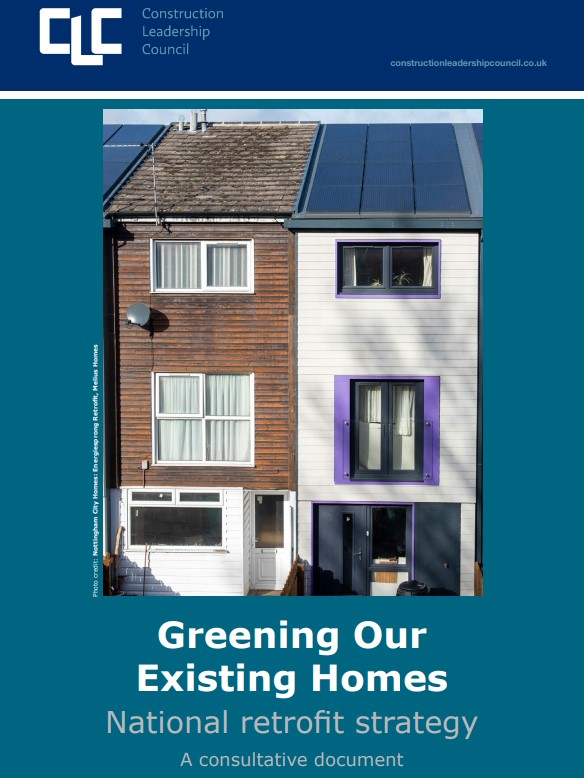National Retrofit Strategy NRS

|
Contents |
[edit] Introduction
In December 2020, the Construction Leadership Council (CLC) announced its support for the creation of a National Retrofit Strategy (NRS). In conjunction with the announcement came the CLC's publication of the consultation, Greening Our Existing Homes.
Following the consultation, the second iteration of the National Retrofit Strategy was published on 28 May 2021, setting out how the construction industry can work with Government to retrofit the UK’s 28 million existing homes.
[edit] Purpose of the NRS
Existing homes use 35% of all the energy in the UK. They are also responsible for 20% of carbon dioxide emissions. The NRS puts forward a plan for upgrades that are vital if the country intends to meet its net zero targets.
The intention of the plan is to help make homes greener and more energy and water efficient, warmer and more affordable to run. This is in line with the UK Government’s target to upgrade as many homes as possible to Energy Performance Certificate (EPC) C by 2035.
[edit] Specific strategies
Ideally, the NRS will aid recovery in the repair, maintenance and improvement (RMI) sector, and provide opportunities for a cohesive approach to addressing the issue of climate change by all parts of the construction industry.
The strategy calls for partnership working between industry and Government based on three key deliverables:
- Creating a ‘building passport’ in the form of building renovation plans for every home.
- Developing skills training modules consistent with PAS 2035/2030 (Retrofit Coordinator training standards)
- Providing delivery programmes in trial areas to serve as best practice models and foster a grassroots approach.
[edit] Development of NRS
The NRS was developed by participants of the Domestic RMI Workstream. This group was formed to bring together specialists and representatives from the supply chain to address sector priorities. The group is one of the CLC’s four sector specific workstreams created to explore issues related to the COVID-19 pandemic recovery.
CLC Steering Coordination Group member Mark Reynolds said, “Retrofit promises a great deal for the sector, including a long-term pipeline of work. Not limited to this, retrofit brings opportunities for upskilling, digitisation and innovation, which are all in line with the Construction Sector Deal.”
[edit] Related articles on Designing Buildings
- CIOB holds net zero event with industry experts and UK Government.
- Construction Leadership Council CLC.
- Energy performance certificate EPC.
- Engineering services and industry recovery guide.
- Households Declare.
- IHBC COP26 podcasts.
- National Retrofit Strategy v2 launches.
- PAS 2035.
- Plan proposes to reinvent construction industry.
- Recommendations for implementation of the National Retrofit Strategy.
- Retrofit.
- Retrofit Coordinator.
- The Construction Playbook.
Featured articles and news
How can digital twins boost profitability within construction?
A brief description of a smart construction dashboard, collecting as-built data, as a s site changes forming an accurate digital twin.
Unlocking surplus public defence land and more to speed up the delivery of housing.
The Planning and Infrastructure bill oulined
With reactions from IHBC and others on its potential impacts.
Farnborough College Unveils its Half-house for Sustainable Construction Training.
Spring Statement 2025 with reactions from industry
Confirming previously announced funding, and welfare changes amid adjusted growth forecast.
Scottish Government responds to Grenfell report
As fund for unsafe cladding assessments is launched.
CLC and BSR process map for HRB approvals
One of the initial outputs of their weekly BSR meetings.
Architects Academy at an insulation manufacturing facility
Programme of technical engagement for aspiring designers.
Building Safety Levy technical consultation response
Details of the planned levy now due in 2026.
Great British Energy install solar on school and NHS sites
200 schools and 200 NHS sites to get solar systems, as first project of the newly formed government initiative.
600 million for 60,000 more skilled construction workers
Announced by Treasury ahead of the Spring Statement.
The restoration of the novelist’s birthplace in Eastwood.
Life Critical Fire Safety External Wall System LCFS EWS
Breaking down what is meant by this now often used term.
PAC report on the Remediation of Dangerous Cladding
Recommendations on workforce, transparency, support, insurance, funding, fraud and mismanagement.
New towns, expanded settlements and housing delivery
Modular inquiry asks if new towns and expanded settlements are an effective means of delivering housing.
Building Engineering Business Survey Q1 2025
Survey shows growth remains flat as skill shortages and volatile pricing persist.






















